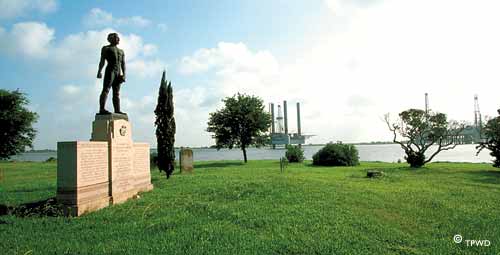Jefferson County is located on the southeast coast of Texas, along the Gulf of Mexico. Established in 1837, the county's namesake is Thomas Jefferson, and the first seat was Old Jefferson in 1835. Beaumont became the new seat in 1838. Atakapa and Orcoquizas Indians lived in the territory until they migrated to other areas on the eve of white settlement in the area in the 1820s.

Northern and Western Europeans, and citizens from other states began to migrate to Jefferson County in the 1830s. The county's main economic source up to the Civil War was timber, sawmills, and cotton. Cotton proved the most viable income item, owing to the success of the plantation system, which lead to an increase in the number of slaves. Jefferson County voted for secession and suffered afterward as a result.
The county's population decreased after the war due to a lack of usable land. Because of this, cotton production declined significantly, along with the sale of timber, cattle, and sugar. Railroads and river travel allowed farmers to ship their items outside the county. The discovery of oil in the early 1900s resulted in a large migration into the area, which created a handful of new jobs and increased revenues in the county ten-fold. The county sidestepped the Great Depression because of the booming oil industry. During this time, land speculation increased and more people became tenant farmers. After World War II, Jefferson County supported itself through agriculture, oil, transportation ventures, and technology innovations.
City/State/Federal - County Commission
Museum/Historic Site
- The Art Studio, Inc.
- Babe Didrikson Zaharias Museum
- Clifton Steamboat Museum
- Dishman Art Gallery
- Edison Museum
- Fire Museum of Texas
- John Jay French Historic House Museum
- McFaddin-Ward House
- Museum of the Gulf Coast
- Sabine Pass Battleground State Historic Site
- Spindletop-Gladys City Boomtown Museum
- Texas Energy Museum
Historical Association/Organization
Documents/Resources
- Books
- US Geodata; Big Thicket National Preserve oil and gas mgt. plans
- Texas Forest Service, Best Management Practices Project (Journal)
- 1990 Census population and housing (Map)
- Flood insurance study city of Beaumont, Texas, Jefferson County (Microfilm)
Text: http://www.tshaonline.org/handbook/online/articles/hcj05 Handbook of Texas Online, Texas State Historical Association.